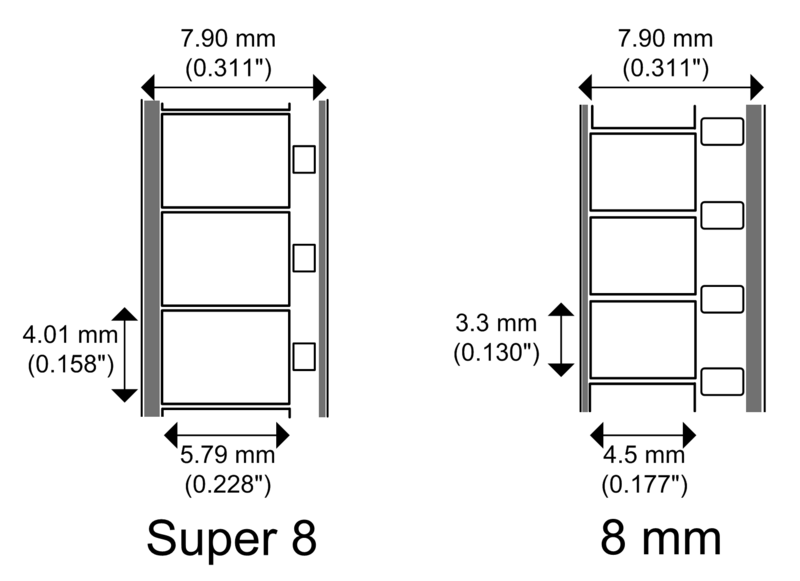
 Standard 8 mm film, also known as Regular 8 mm film, Double 8 mm film or simply as Standard-8 or Regular-8, is a film format originally developed by the Eastman Kodak company and released onto the market in 1932.
Standard 8 mm film, also known as Regular 8 mm film, Double 8 mm film or simply as Standard-8 or Regular-8, is a film format originally developed by the Eastman Kodak company and released onto the market in 1932.The format, initially known as Cine Kodak Eight, was developed by Kodak to provide a cheaper and more portable alternative to the 16 mm film format introduced a decade earlier.
Standard 8 mm film stock consisted of 16 mm film reperforated to have twice the usual number of perforations along its edges, though using the same size sprocket holes. This film was run through the camera, exposing one edge of the film only (the frame size of standard 8 mm film is 4.8 mm x 3.5 mm). The spool was then reversed and the film run through again, exposing the other edge. After processing the film was cut down the centre and spliced together to give one roll of 8mm wide film. The standard spool size for amateur use contained 25 ft of film, giving a total of 50 ft available for projection; at the usual filming speed of 16 frames per second this would give around three and a half minutes of footage.
The format was an immediate success, but retained a number of inherent problems and quirks, mostly connected with the fact that the spool needed to be removed and reversed half way through filming. This procedure was tricky for the inexperienced user and needed to be carried out in subdued light to avoid fogging of the edges of the film. In addition, the central six feet of the finished film would include a characteristic burst of light corresponding to the reversal point (unless the film was again edited and spliced).
In the early 1960s, a new filming and projection standard of 18 frames per second was introduced, although many cameras and projectors included a multi-speed facility.
The standard 8 mm format was quickly displaced by the Super 8 mm film format - which offered cartridge loading, a 50% larger frame size and electric-powered cameras - from the mid 1960s onwards. However, standard 8mm retained some advantages over Super 8: in particular, the latter's use of cartridges with an integral film pressure plate resulted in a less steady image than the earlier format, in which the pressure plate was part of the camera itself. More sophisticated standard 8 mm cameras permitted backwind of the film - not possible with a Super 8 cartridge - enabling simple double-exposure and dissolve effects to be made in-camera. Super 8's smaller sprocket holes, while allowing a larger frame size, were also inherently more liable to tear.
Manufacturers
The first camera produced was Kodak's own Cine Kodak Eight Model 20. Like many subsequent cameras, it was extremely simple and powered by clockwork. The Swiss company Paillard-Bolex SA introduced its first 8 mm camera in 1938 and its first 'pocket' 8 mm camera aimed squarely at the amateur market, the L-8, in 1942. Bolex cameras and projectors continued to occupy the high end of the market. In the US, Bell and Howell introduced an 8 mm projector in 1934, and in 1935, the Filmo Straight Eight camera, using pre-prepared 8 mm wide film. Standard 8 mm equipment was also manufactured by Carl Zeiss, the Austrian firm Eumig, Fuji (as Fujica), and Canon, amongst others.
[edit] Film stocks
The most commonly used film stocks were produced by Kodak. In particular, the 10 ASA Kodachrome colour reversal stock, with its distinctive colour rendition and fine grain, was closely associated with the format. Kodachrome II, rated at 25 ASA, was introduced in the early 1960s. Kodak continued to produce standard 8 mm film directly up until the early 1990s, although its 16mm stocks are still reperforated and respooled by other companies. Other film stocks from different manufacturers, such as Agfa's Agfachrome, were also available.
Kodachrome's excellent archival qualities mean that old 8mm film can still appear remarkably fresh if stored in the correct conditions.
[edit] Standard 8mm variants
Various attempts were made to simplify use of standard 8mm film over the years, but none was especially successful. The Straight Eight format, using pre-prepared 8mm wide film, had some popularity in Europe, where Agfa manufactured their own stock. Kodak eventually introduced a magazine-loading system, but it was never as popular as spooled 8mm film and was discontinued by the early 1980s. Some manufacturers (e.g. Pentacon in East Germany) made cameras with special magazines that could be pre-loaded with 8 mm spools. They were simply pulled out and flipped in mid-roll, avoiding re-threading the film.
[edit] Packaged movies
Although standard 8 mm was originally intended as a format for creating amateur films, condensed versions of popular cinema releases were available on the format up until the 1970s, for projection at home. These were generally edited to fit onto a 200 ft reel. Many Charlie Chaplin films, and other silent movies were available. The Walt Disney Studio released excerpts from many of their animated feature films, as well as some shorts, in both Standard and Super 8, some even with magnetic sound. New releases of material were not stopped until the late 1970s in the US.